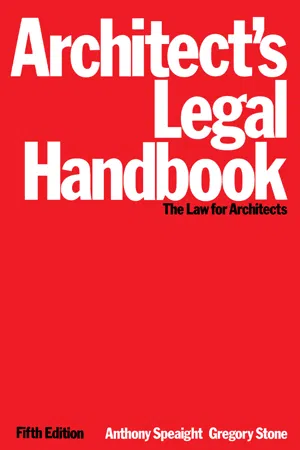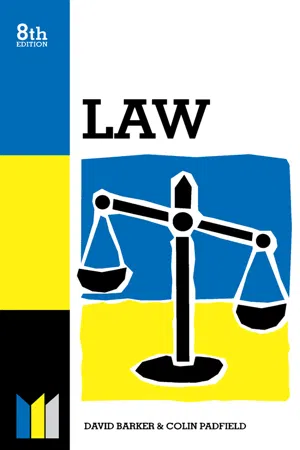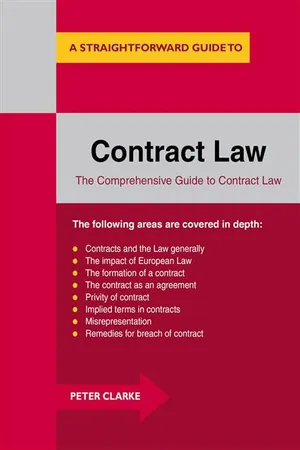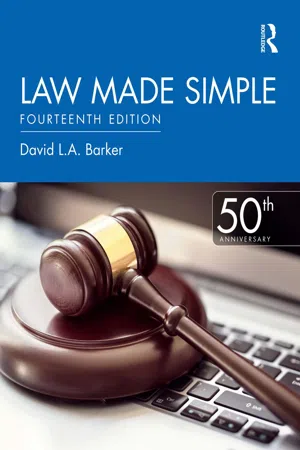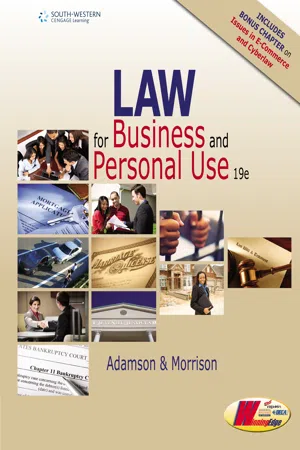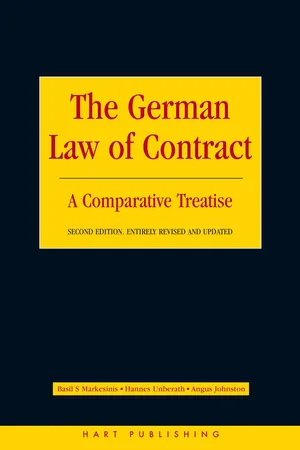Law
Contract Offer
A contract offer is a proposal made by one party to another, expressing a willingness to enter into a legally binding agreement. It must contain specific terms and be communicated to the offeree with the intention of creating a contract. Once the offer is accepted, a binding contract is formed, provided that all other necessary elements are present.
Written by Perlego with AI-assistance
Related key terms
1 of 5
11 Key excerpts on "Contract Offer"
- eBook - PDF
Commercial Contracts
A Practical Guide to Deals, Contracts, Agreements and Promises
- Chris Thorpe, John Bailey(Authors)
- 1996(Publication Date)
- Woodhead Publishing(Publisher)
In section 3.1.8 we will question whether every contract can be analysed in this way, but we must begin by understanding what these terms mean and by taking a close look at the process by which every contract supposedly comes into existence. 3.1.1 Offer An offer is a proposal which will result in a contract if the person to whom the proposal is made simply accepts it. This means that the t( proposal must be (1) complete and (2) made with contractual inten-tion. We discussed contractual intention at length in section 1.4 and we need say no more here other than to note that a proposal made without contractual intention (the plainest example of which is a 'subject to contract' proposal) is not a contractual offer and does not result in a contract if it is accepted. We do however need to consider further the requirement that the proposal is complete. In order for a contract to come into existence the parties must be in agreement not only on the basic terms of the transaction but also on all other matters which have been raised in the course of the negotiations between them. The basic terms of the transaction (dis-cussed in section 4.2.1) are the minimum which the parties must have agreed if a contract is to exist: with for example a contract for the sale of goods the parties must as a minimum have agreed what goods are to be sold and what price is to be paid for them. But if in the course of their negotiation the parties have discussed other matters such as warranties, delivery date and the timing and 40 down to business. In the remainder of the chapter we will turn to the broader commercial realities of entering into a contract (section 3.3), to the problem of non-disclosure (section 3.4) and finally to tendering (section 3.5). Entering into a contract 41 method of payment, then no contract can come into existence until all these other terms have been agreed. - eBook - PDF
Architect's Legal Handbook
The Law for Architects
- Anthony Speaight, Gregory Stone(Authors)
- 2014(Publication Date)
- Butterworth-Heinemann(Publisher)
The recipe is simple: offer and acceptance. Offer 6.04 An offer is a promise, made by the offeror, to be bound by a contract if the offeree accepts the terms of the offer. The offer matures into a contract when it is accepted by the other party. 6.05 The offer can be made to just one person (the usual case) or it can be made to a group of people, or even to the world at large. The case of Carlill v Carbolic Smoke Ball Company [1892] 2 QB 484, [1893] 1 QB 256, is an example of an offer to all the world. The defendant company manufac-tured a device called a carbolic smoke ball, which was intended to prevent its users from catching flu. They advertised it with the promise that they would pay £100 to anybody who used the smoke ball three times a day as directed and still caught flu. The unfortunate plaintiff caught flu despite using the smoke ball, and not unnaturally felt she was entitled to the £100 offered. The Court of Appeal held that the company's advertisement constituted an offer to contract, and by purchasing the smoke ball the plaintiff had accepted the offer, so that a contract was created. Accordingly the plaintiff successfully extracted her £100 from the company. 6.06 Not all pre-contractual negotiations are offers to contract. In deals of any complexity there will often be a lot of exploratory negotiation before the shape of the final contract begins to emerge, and it is not until a late stage that there will be a formal offer to contract by one party to the other. 6.07 Easy to confuse with an offer to contract is an invitation to treat. An invitiation to treat is an offer to consider Terms of a contract 11 accepting an offer to contract from the other party. Most advertisements 'offering' goods for sale, and also the goods lying on a supermarket shelf with their price labels, are merely invitations to treat. - eBook - PDF
- Chris Turner(Author)
- 2013(Publication Date)
- Routledge(Publisher)
Formation of a contract: agreement Formation of contracts? 5 5 The existence of an agreement is measured objectively in English law, and so is as much to do with the surrounding factual circumstances as it is to do with the state of mind of either party. 6 Judges have strained the basic principles in order to find consideration to enforce promises that they believe are made in a context that should make them binding. The character of an offer • A statement of willingness to be bound by the terms of the offer. • Must be distinguished from an invitation to treat (Fisher v Bell). • Should be distinguished from a mere statement of price, which does not indicate willingness to sell [Harvey v Ғасеў). • Special words may make an apparent invitation to treat an offer (e.g. competitive tendering [Harvela Investments Ltd v Royal Trust Co of Canada). . ________________________ Λ Communicating an offer • Must be communicated to the offeree (Taylor VLaird). • Can be made to an individual or to the whole world ( Carlill v Carbolic Smoke Ball Co). • The terms must be certain (Guthing V Lynn). Revoking an offer • It may be withdrawn any time up to acceptance ( Routledge v Grant). • Revocation must be communicated to the offeree (Byrne v Van Tienhoven). • This may be through a reliable third party (Dickinson v Dodds). • A unilateral offer cannot be withdrawn while the offeree is still performing (Errington v Errington & Woods). OFFER Terminating an offer An offer ends in one of three ways: • by passage of time - either i) the stated time or ii) a reasonable time; • by failure of a condition precedent; • by death of a party. 6 Formation of a contract: agreement Z 2.2 Offer 2.2.1 The character of an offer 1 A contract usually begins with acceptance of an offer. - eBook - PDF
Law
Made Simple
- D. L. A. Barker, C. F. Padfield(Authors)
- 2014(Publication Date)
- Made Simple(Publisher)
7 THE LAW OF CONTRACT In his book Principles of the Law of Contracts, Sir William Anson defined a contract as a legally binding agreement made between two or more parties, by which rights are acquired by one or more to acts or forebearances on the part of the other or others. Shortly it may be defined as an agreement between two or more parties which is intended to have legal consequences. The agreement referred to in the definition means a meeting of minds, called in law consensus ad idem, signifying that the parties are agreed together about the same thing. The definition also emphasizes that the parties to the contract must intend that their agreement shall be legally enforceable. Unless the law regognizes this and enforces the agreements of parties, it would be impossible to carry on commercial or business life. For this reason the law of contract plays a leading role in courses on business studies. These contractual agreements give rise to rights and obligations which the law recognizes and enforces. But certain agreements, such as domestic and social arrangements, are not intended by the parties to be legally binding. The law allows for this. Thus, if Cumming and Gowing agree to meet for dinner and Gowing fails to turn up, the law will do nothing in the matter. The agreement was not intended to create legal rights and duties, and, as such, it is not a contract in law. Every contract is an agreement, but not every agreement is a contract. The object of the law of contract is to identify those agreements which it will enforce and those which it will not. This is of prime importance and will be referred to later in more detail. 1. Essentials of a Valid Contract An agreement will be enforced when the following essential elements exist: (a) Offer and Acceptance. There must be an offer by one party and an acceptance of it by the other. (b) Intention to create legal relations. (c) Capacity of the parties. Each party must have the legal capacity to make the contract. - eBook - ePub
- Chris Turner(Author)
- 2014(Publication Date)
- Routledge(Publisher)
2 Formation of a contract: Offer and acceptance AIMS AND OBJECTIVES After reading this chapter you should be able to:Understand the essential requirements for valid formation of a contractUnderstand the basic character of an offerDistinguish between an offer and an invitation to treatUnderstand the need for communicationUnderstand how offers can be withdrawn and in what circumstancesUnderstand how an offer can be terminatedUnderstand the basic character of acceptanceDistinguish between a counter-offer and a mere enquiryUnderstand the significance of different methods of communicationUnderstand the circumstances in which unilateral contracts are madeCritically analyse the areaApply the law to factual situations and reach conclusions2.1 Formation of contracts and the concept of agreementWe know from our introduction to the law of contract that the law concerns ‘bargains’ that are made between parties. The major significance of the word ‘bargain’ is that it involves an agreement that is binding on both parties. In contract law, then, it is insufficient merely that an agreement exists between two parties but rather that it involves that specific type of agreement which is enforceable by both parties in a court of law.A contract is completed when both sides honour an agreement by carrying out their particular side of the bargain. It is a breach of contract when a party fails to do so.However, because of the special nature of contractual agreements, we cannot identify a breach of contract where we may feel that we have not got what we paid for or ‘bargained’ for, without first showing that the agreement was indeed a contract.So the first thing that may need to be determined in any contract case is that there is proof that a contract actually exists, as opposed to some less formal, and thus unenforceable, arrangement between the parties. It is possible to tell if the arrangement is a contract because to be so it must have been formed according to certain standard rules. These are the rules of formation of contract - eBook - ePub
- Kenny Chin(Author)
- 2014(Publication Date)
- Routledge-Cavendish(Publisher)
Contract law is categorised in the law of obligation. A contract creates a legal obligation between the contracting parties. When one party has not fulfilled, or is not going to fulfil the obligation, he can be sued for breach of contract. The court will help the innocent party by either ordering damages suffered to be compensated, compelling the party in breach to perform the contract (specific performance order) or prohibiting the wrongdoer to act in a way which would cause further breaches (injunction order). It is therefore important to know how and when a binding agreement has been created. The following are six main essentials for a contract to be formed, they are:- offer and acceptance;
- consideration;
- intention to create legal relationship;
- capacity;
- legality;
- consensus ad idem (meeting of minds).
For a contract to exist, the first three essentials have to be present. Without any of them, no contract has been formed in the first place. It is quite different when any of the latter three essentials is absent. If a party who lacks legal capacity, for example, a minor, makes a contract, the law recognises the contract, but may also intervene by giving the minor the option to avoid the contract. Therefore, the contract is not void, but is said to be voidable. If a contract is made with an illegal objective, the court will not enforce the contract, in other words, there is a contract, but it is unenforceable. When a person enters into a contract caused by fraud, misrepresentation, a serious mistake, duress or undue influence, there is, in effect, no meeting of minds. In some cases, the contracts are void and in others they may be voidable.OfferSir Guenter Treitel in his book, The Law of Contract, defines an offer as an expression of willingness to contract on certain terms made with the intention that it shall become binding as soon as it is accepted by the person to whom it is addressed.There are further rules, mostly created by common law, relating to ‘offer’. These are: Offer must be communicated to the offereeAn offer is an expression of willingness to contract and it must be expressed or communicated to a person, otherwise the person cannot accept something he is unaware of. For example, a reward has been offered for returning a lost item. If a person returns the item and, at the time, he does not know of the offer, then the offeror is not liable to reward him because he has not accepted anything and, therefore, there was no contract binding the parties. - eBook - ePub
Contract Law
A Straightforward Guide
- (Author)
- 2014(Publication Date)
- Straightforward Publishing Digital(Publisher)
As we have seen, for a contract to have legal status, usually one of the parties to the contract must have made an offer and the other party must have accepted the offer. Once the contract is accepted the agreement will be legally binding. The person making the offer is called the offeror and the person to whom the offer is made is known as the offeree. An offer may be express or implied. Express means that there is an express intention to offer goods and for X to pay an amount for the goods. Implied may mean, for example, when purchasing something from a store. The act of taking goods to a checkout means that there is an implied offer to buy those goods.When dealing with contracts, or the formation of a contract most offers are made to specific parties. However, offers can also be made to a group of people or to the public at large. One such example is where a reward is offered for information following a crime.One famous case dealing with offers to the public at large is Carlill v Carbolic Smokeball (1893) the defendants in this case were the manufacturers of ‘smokeballs’ popular at the time, which they claimed could prevent flu. They published adverts to this effect stating that anyone using their smoke balls and not being cured of flu would receive £100. One person buying their smokeballs was a Mrs Carlill. It did not work and she claimed the £100. The manufacturers argument was to claim that their advert did not constitute a contract, since it was impossible to contract with the whole wide world. They claimed that they were not legally bound to pay the money. The court, needless to say, rejected this argument, which held that the advert did contract with the world. Mrs Carlill accepted the offer and duly claimed the £100. A contract such as the one above is usually a unilateral contract.The invitation to treat
Certain kinds of transactions between parties might involve a preliminary stage where one party to the contract invites the other party to make an offer. This preliminary stage is known as ‘invitation to treat’.One such case that demonstrates this is that of Gibson v Manchester City Council (1979). In this case, a council tenant of Manchester City Council expressed an interest in buying their house. The application was duly completed and sent to the council. A letter was received from the council stating that it may be prepared to sell the house to the tenant for £2180. The tenant, Mr Gibson, queried the purchase price pointing out that the path to the house was in bad condition. The council refused to alter the price, stating that the valuation reflected the condition of the property and the current property market. Mr Gibson then wrote asking the council to continue with the sale. Following a change in the control of the council, and a new political approach, it was decided to stop the sale of houses to tenants. Mr Gibson was informed that his application had been declined, notwithstanding the initial offer. Legal proceedings were brought against the council claiming that the letter received by Mr Gibson, with the offer of sale at a price, constituted a contract, and was an offer which he duly accepted. The House of Lords, however, ruled that the council had not made an offer, the letter stating the purchase price was merely one step in the negotiations for a contract and amounted only to an invitation to treat. Its purpose in the first instance was quite simply to invite the making of a formal application, amounting to an offer, from the tenant. - eBook - ePub
- David L.A. Barker, David L. A. Barker(Authors)
- 2020(Publication Date)
- Routledge(Publisher)
Chapter 7The law of contract
Key points
- what constitutes a contract
- the essentials of a valid contract
- void, voidable and illegal contract
- the ways in which a contract may be discharged
- remedies for breach of contract
In his book Principles of the Law of Contracts , Sir William Anson defined a contract as a legally binding agreement made between two or more parties, by which rights are acquired by one or more to acts or forbearances on the part of the other or others . Shortly it may be defined as an agreement between two or more parties that is intended to have legally enforceable consequences.The agreement referred to in the definition means a meeting of minds, called in law consensus ad idem , signifying that the parties are agreed together about the same thing. The definition also emphasizes that the parties to the contract must intend that their agreement shall be legally enforceable. Unless the law recognizes this and enforces the agreements of parties, it would be impossible to carry on commercial or business life. For this reason the law of contract plays a leading role in courses on business studies.These contractual agreements give rise to rights and obligations that the law recognizes and enforces. But certain agreements, such as domestic and social arrangements, are not intended by the parties to be legally binding. The law allows for this. Suppose, if Cumming and Gowing agree to meet for dinner and Gowing fails to turn up, the law will do nothing in the matter. The agreement was not intended to create legal rights and duties, and, as such, it is not a contract in law. Every contract is an agreement, but not every agreement is a contract.The object of the law of contract is to identify those agreements that it will enforce and those that it will not. This is of prime importance and will be referred to later in more detail.An agreement will be enforced when the following essential elements exist:7.1 Essentials of a valid contract
- Offer and acceptance
- John Adamson, Amanda Morrison(Authors)
- 2016(Publication Date)
- Cengage Learning EMEA(Publisher)
2. GENUINE ASSENT The agreement must not be based on one party’s deceiving another, on an important mistake, or on the use of unfair pressure exerted to obtain the offer or acceptance. 3. LEGALITY What the parties agree to must be legal. An agreement to commit a crime or tort cannot be a legally enforceable contract. 4. CONSIDERATION What the promisor demands and generally must receive in order to make his or her promise legally enforceable against him or her is termed consideration . 5. CAPACITY To have a completely enforceable agreement, the parties must have the legal ability to contract for themselves. Age of the parties is one aspect of capacity. In most states, parties to a contract must be 18 in order to form a legally binding contract. 6. PROPER FORM Some agreements must be placed in writing to be fully enforceable in court. WHAT’S YOUR VERDICT? LEGAL VOCABULARY contracts, p. 113 offeror, p. 113 offeree, p. 113 consideration, p. 113 executed contract, p. 114 executory contract, p. 114 express contract, p. 114 implied-in-fact contract, p. 114 implied-at-law (quasi) contract, p. 114 unilateral contract, p. 114 bilateral contract, p. 114 offer, p. 114 ■ List the elements required to form a contract ■ Describe the requirements of an offer GOALS 6-1 Creation of Offers IN THIS CASE When you told Sheila how nice the paint job was on her car, she responded that she painted cars in her garage for a second income. She took a close look at your vehicle. Then she said that, if you agreed, she would do a similar job on it with the color of your choice in the next week for $1,800. In this situation, Sheila is the offeror and you are the offeree. © TIM MAINIERO, SHUTTERSTOCK; © MICHELANGEIUS, SHUTTERSTOCK; © JIM BARBER, SHUTTERSTOCK Copyright 2017 Cengage Learning. All Rights Reserved. May not be copied, scanned, or duplicated, in whole or in part. Due to electronic rights, some third party content may be suppressed from the eBook and/or eChapter(s).- eBook - PDF
The German Law of Contract
A Comparative Treatise
- Basil S Markesinis, Hannes Unberath, Angus C Johnston(Authors)
- 2006(Publication Date)
- Hart Publishing(Publisher)
But if the conduct were completely referable to another motive, then the courts have refused to find the offer to have been accepted; The Crown v Clarke (above), although cf Mitchell and Phillips, ‘The Contractual Nexus: Is Reliance Essential?’ (2002) 22 OJLS 115). ‘Offers’ in the technical sense, ie an offer to enter into a contract, are subject to acceptance and therefore in the end must reach a particular addressee (however, see the possibilities of offers ad incertas personas, above). This is true of all declarations of intention which affect the content or the validity of a contract (eg, rescission, § 143 BGB). The first condition for a declaration of intention is that the intention is declared externally. An offer, being a declaration with a particular addressee, must be commun- icated to that person. A number of specific requirements must be satisfied before the offer can be regarded as properly communicated to the offeree. This is of great import- ance, for unless the offer is communicated it does not have any of its desired legal effects (for instance it is not binding in the sense of § 145 BGB). Furthermore, the offer can be withdrawn according to § 130 I 2 BGB (Widerruf) provided that the withdrawal is communicated at the same time or before the offer itself is communicated. (As noted above in discussing the irrevocability of offers in German law, English law takes a rather different view: an offer may be withdrawn at any point in time, unless it has been accepted. Often, the apparent rigours of this approach are mitigated by the use by the offeror of specified time limits within which acceptance must be made, or by the con- clusion that merely acting inconsistently with the offer (eg, by selling the item offered to a third party in the interim) does not, without more, amount to a withdrawal of the offer (Adams v Lindsell (1818) 1 B & Ald 681; 106 ER 250).) 68 THE FORMATION OF THE CONTRACT - eBook - PDF
- Richard Mann, Barry Roberts(Authors)
- 2019(Publication Date)
- Cengage Learning EMEA(Publisher)
Acceptance of an offer for a bilat- eral contract is some overt act by the offeree that mani- fests his assent to the terms of the offer, such as speaking or sending a letter, or using other explicit or implicit com- munication to the offeror. If the offer is for a unilateral contract, acceptance is the performance of the requested act with the intention of accepting. For example, if Joy publishes an offer of a reward to anyone who returns the diamond ring that she has lost (an offer to enter into a unilateral contract) and Bob, with knowledge of the offer, finds and returns the ring to Joy, Bob has accepted the offer. FIGURE 10-1 Duration of Revocable Offers Offer Effective Communicated Intent Definite and certain OFFER OPEN Offer Terminated Lapse of time Revocation Rejection Counteroffer Death Incompetency Destruction of subject Subsequent illegality No Offer No Offer 208 Contracts Part III COMMUNICATION OF ACCEPTANCE [10-3] General Rule [10-3a] Because acceptance is the manifestation of the offeree’s assent to the offer, it must necessarily be communicated to the offeror. This is the rule as to all offers to enter into bilateral contracts. In the case of unilateral offers, however, notice of acceptance to the offeror usually is not required. If, however, the offeree in a unilateral con- tract has reason to know that the offeror has no adequate means of learning of the offeree’s performance with rea- sonable promptness and certainty, then the offeree must make reasonable efforts to notify the offeror of accep- tance or lose the right to enforce the contract. Silence as Acceptance [10-3b] An offeree is generally under no legal duty to reply to an offer. Silence or inaction therefore does not indicate acceptance of the offer. By custom, usage, or course of dealing, however, the offeree’s silence or inaction may operate as an acceptance.
Index pages curate the most relevant extracts from our library of academic textbooks. They’ve been created using an in-house natural language model (NLM), each adding context and meaning to key research topics.

